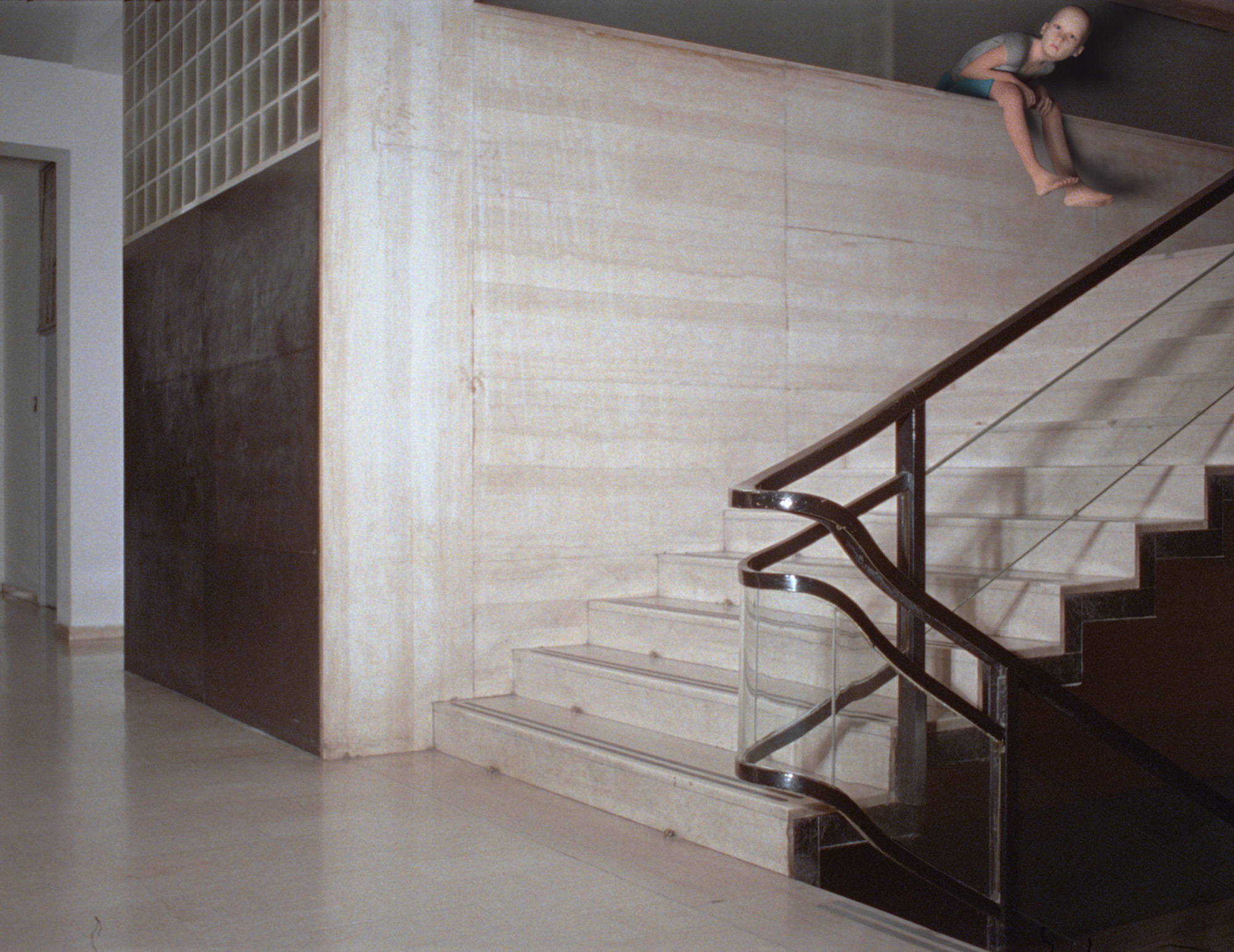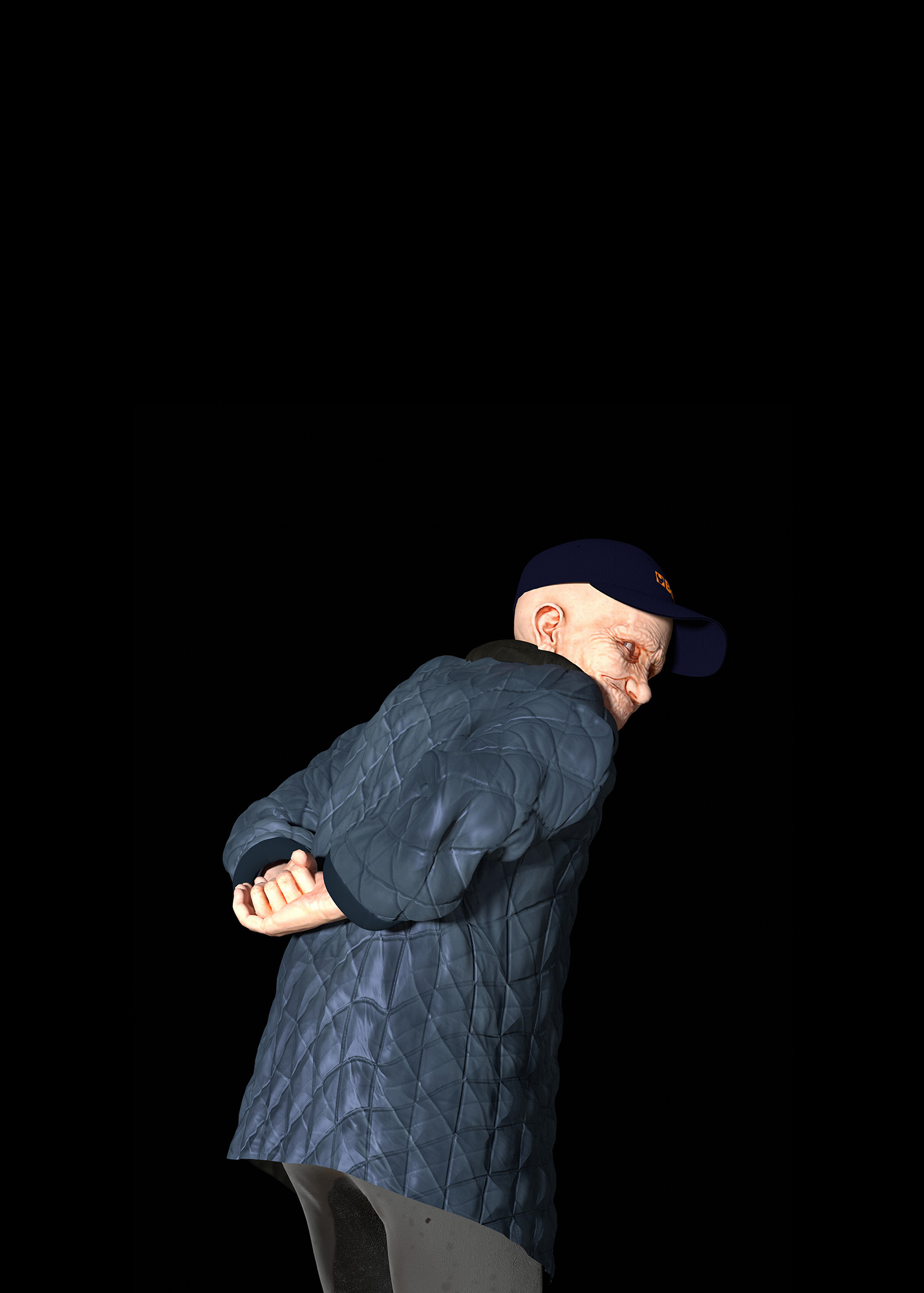A
Haunting Sense of Power: Monelle at Sadie Coles HQ
A chilling & haunting film of uncanny people & place fills the darkness of the Sadie Coles gallery. In Monelle, a film by Italian artist Diego Marcon, Como’s modernist Casa del Fascio is the backdrop for CGI characters, as witnessed by Rochelle Roberts.
The room is dark when you enter, except for the light from the doorway and the flickering black screen. There is a sense of unease, the feeling of having entered a space that is unknown. Monelle, a film by Italian artist Diego Marcon, is made up of long periods of darkness which are broken only by momentary flashes of light, accompanied by a loud bang, which illuminate isolated scenes, just long enough for them to register before disappearing into darkness once more.

Many of the scenes contain girls in varying states of immobility and passiveness, sitting on stairs, leaning against hard walls. In others, we see parts of the building that the girls occupy; cold, dark spaces that feel austere and unforgiving. At times, CGI generated figures materialise, strange apparitions that do not quite belong. As the film progresses, is it clear that it is concerned with representations of violence and power that are expressed in both subtle and overt ways. But there is also a sense of the significance of place, the juxtaposition of past and present, reality and unreality.
In Monelle, what feels immediately obvious is the use of horror as a device through which to interrogate the manifestation of authority and oppression - the very violent flashes of light, the loud noises, and the murky dark makes the film physically difficult to watch. You find that you squint your eyes slightly to avoid the light seeming so bright. You anticipate your way through the darkness, waiting intently for the next burning flash but unsure when exactly it will come. There is a tenseness that is intrinsic to the limit placed on the senses.

Marcon is interested in the audio-visual language of horror films, the way they build suspense and fear as a means to scare the audience. This is evident in the way the vignettes of Monelle seem to escalate: a girl, sleeping against a wall; a girl with her back toward the viewer; a body being dragged along the floor; a body falling. The latter image is particularly powerful precisely because of the use of sound and visual elements that force the viewer to, in other words, fill in the blanks. We see the body fall from a balcony. The screen goes black while the body is still moving through space, but there is no doubt what happens. Through the darkness we hear the thud – then imagine the body crushed against the floor.
Monelle’s setting provides a backdrop that heightens the eery atmosphere. Shot in Casa del Fascio in Como, Italy on a 35mm film, it reveals the subtle instances of domination through the imposing structure and hard surfaces of the building. Designed by the renowned Modernist architect Giuseppe Terragni, Casa del Fascio was originally used by the National Fascist Party under Mussolini in the late 1930s and early 1940s.

Typical of the style of architecture in Italy during that time, the Casa del Fascio – now also referred to as the Palazzo Terragni – is large and rigidly symmetrical, with an interior and exterior made of sharp, straight edges. Within the film, the building’s grandiosity, its imposing nature, is a sort of menacing presence in itself. It is haunted by the violent regime of its past under fascism, demonstrating the capability of a building to hold the ghosts of history and adding to the disquiet of the film.
“I wanted Monelle to be set in a place of power and administration but not in the place of a specific power or administration.” Marcon tells recessed.space. “Inside the [Casa del Fascio] you have the distinct sensation of moving around a place of power, yet one manifested in a subtle and restless manner; it’s a restlessness which is the reflection of a form of politics meant as an invisible, penetrating, and all-enveloping force.” The artist continues, “This is a sentiment which is not directly connected to a given historical period or a given power, but which concerns an ontological aspect of the dynamics of power that the Casa del Fascio brings to light thanks to the formal synthesis it represents.”

The suffocating and frightening quality of Monelle is intensified by its non-linearity. There is no real beginning or end, it plays in a thirteen-minute loop that somehow makes time disintegrate. The momentary glimpses of scenes make it impossible to be rooted in a specific moment. Instead, you are left suspended in darkness, with only an arbitrary notion of time passing. Because of this, it is easy to watch several loops of the film without realising it, such is the intensity in which you are held; it makes the world beyond the room disappear.
The liminal quality of time is also echoed in the representation of absence, the traces of things left behind. After a scene flashes before our eyes, we are left with the after-image of what was, existing both in the past and the present. Plunged into darkness, we are drawn to the traces of what we cannot see, the things happening out of shot, bleeding along the edges and out of sight. We try to make sense of the images but there is no resolution. The CGI figures act as a way to question what is real and what is merely perception. Their uncanniness is at odds with the girls, the fleshiness of real human skin, and with the solid unmoving structure of the Casa del Fascio.
This contrast of human and CGI is, for Marcon, an important element of the work because it allows for the creation of ambiguous and opaque images. The CGI figures are like ghosts, presences that are stuck between two opposing states, almost transcending the physical environment in which they appear, while the girls are resolutely tethered to the Casa del Fascio, intimately bound by touch, by their bodies propped against the building’s interior, unable to escape.

Diego Marcon (b. 1985, Busto Arsizio, Italy) graduated from IUAV University of Arts of Venice (2012) and currently lives and works in Milan. Primarily focussing on moving image, his practice centres on the investigation of cinematic archetypes in a process combining theoretical and structural approaches to filmmaking, with the sentimental attitudes of popular movie genres. His works – spanning film, video and installation – often utilise a looped structure to articulate an emotional display that flirts with the pathetic aspects of popular entertainment; and simultaneously draws attention to the media itself. Throughout Marcon’s work, empathy and vulnerability are deployed with intentional ambiguity, such that the instrumental use of their forms and figures constitute a blurred morality. This ambiguity is viewed by Marcon first and foremost as a political weapon of defiance.
Monelle has been recognised with major awards including the Jury Award – Deframed
Competition, Hamburg International Short Film Festival 2018; Mirage –
Outstanding Art Exploration Award, Beijing International Short Film Festival
2018; and both the Explora Award, Best Experimental Film, and Young Jury Award,
Curtocírcuito. 15° Festival Internacional de Cine 2018. In addition, the work
has been screened at numerous festivals including the International Film
Festival Rotterdam 2018; BFI London Film Festival 2018; Courtisane Festival
2018 – Notes on Cinema, Gent; Cinéma du reel 2018 – International Shorts
Competition, Paris; doclisboa'18 – 16° festival internacional de cinema 2018 –
New Visions, Lisbon; Short Wave Film Festival 2019 and LSFF, ICA London 2020,
among others.
www.diegomarcon.net
Rochelle Roberts is a writer and
editor based in London. Her writing has been published by Prototype, Arusha
gallery, Poetry Birmingham Literary Journal, Art of Choice, and Maximillian
William gallery, amongst others. Her debut pamphlet Your Retreating
Shadow was published in 2022 by Broken Sleep Books and she is a
contributor to the book Cusp: Feminist Writings on Bodies, Myth &
Magic (Ache, 2022).
www.rocheller.weebly.com
www.rocheller.weebly.com
visit
Monelle, by Diego Marcon, is showing at Sadie Coles gallery
on 1 Davies Street, W1, London until 18 March 2023. FOr more information & opening times visit:
https://www.sadiecoles.com/exhibitions/944-diego-marcon-monelle
images
installation views © Diego Marcon, courtesy Sadie Coles HQ, London.
Photo: Katie Morrison
film stills Credit: © Diego Marcon, courtesy Sadie Coles HQ, London.
publication date
03 February 2023
tags
Casa del Fascio, CGI, Sadie Coles, Como, Darkness, Film,
Ghost, Horror, Diego Marcon, Monelle, Giuseppe Terragni, Palazzo Terragni, Power, Rochelle
Roberts, Violence
https://www.sadiecoles.com/exhibitions/944-diego-marcon-monelle


